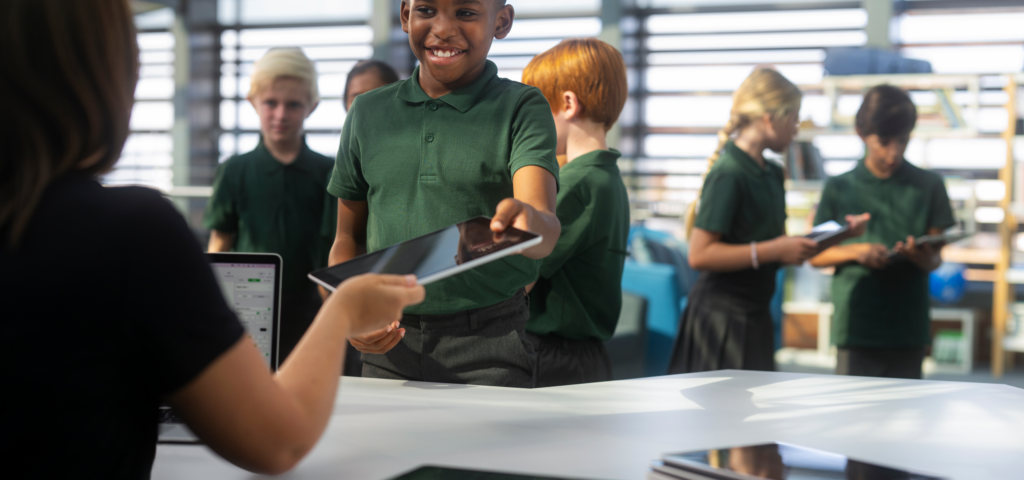
How To Select The Best eLearning
Device For School Students?
The Indian education technology (EdTech) sector has been going through an exciting evolution for quite some time now. The interest of investors and enormous business valuations of companies like Byju’s, Vedantu, UnAcademy, Upgrade, and others are a testament to how well Indian students have received the tech-enabled education. Even before COVID-19, the progress was tremendous. Byju’s had 2.8 million paid students by the end of 2019, and COVID-19 seems to have laid down a foundation for an even brighter future for EdTech companies. By early August 2020, Byju’s had over 57 million registered users and 3.5 million paid students.
While the initial adoption of digital learning solutions came from the professional sector, usage of products for students was primarily limited to urban areas, given the costs involved. However, as COVID-19 pushed the primary education sector online, the adoption of technology in education grew in the economically weaker sections and the rural regions as well, aided by the robust penetration of internet connectivity in the country. As the trends grow, so does the need to invest in smart devices like smartphones, tablets and laptops.
Per Family Device Needs Have Gone Up
A typical urban Indian family with school-going children had one or two computers (including office laptops), and two smartphones. These devices were used by children for learning and entertainment purposes. Post-Covid19, work shifted to home, and the computers stayed occupied all day. As schools went online, considering a typical Indian family of four (parents and two kids), there is a shortage of two devices.
Initially, people shared devices, assuming the study-from-home situation would be temporary. However, as the pandemic continues, a lot of parents have had to seriously consider buying dedicated learning devices for children.
Going forward, there is also a great possibility of online education continuing in parallel to in-person education, given the benefits that technology brings to the table. A lot of people have been able to experience how modern Learning Management Systems (LMS) make education more efficient, personalised and easier to monitor than before. For example, Ignite is an LMS for iPads which can be completely customised by schools to extend their own curriculum and teaching style to remote education. Emerging technologies like Augmented Reality (AR) and Virtual Reality (VR) have given a new dimension to learning, and engage students in amazing new ways.
It means that families will continue to invest in capable devices that can ensure comfortable, valuable and cost-effective learning for school children. Dr Rajesh Tandon, Founder President of PRIA (Participatory Research in India) says,
“Investments in making personal devices available to all girls (and boys) in all households may well be an important investment in the post-pandemic era.”
Three Cs of Device Selection
The three factors that must be considered for choosing an appropriate device are Capabilities, Comfort and Cost. All three can be better optimised when devices are procured and assigned to students by their schools. For individual students, let’s evaluate the choices on these factors.
1) Capabilities
While laptops or desktop computers would undoubtedly provide maximum capability in general, the new generation of smartphones and tablets are not far behind. While the smartphone is again restricted by the small screen size for advanced functionalities, that is not the case with tablets. A good tablet can comfortably support advanced educational apps, tools for creative design, shooting & editing videos, making music, and much more. Technologies like AR and VR have come of age, and powerful new apps have been designed to engage students meaningfully and creatively. Apple iPad, for example, has proved to be a very effective tool for education around the world, in conjunction with Apple’s extensive ecosystem of learning tools, teaching resources and excellent educational content.
A good tablet has a stable, secure operating system and a good battery life. It has great connectivity and compatibility, which allows students to connect seamlessly with networks and other devices. This ensures that they can focus on applying their tablets to meaningful pursuits rather than wasting their time-fighting technology issues.
2) Comfort
If we compare three form factors without any context, smartphones will prove to be the most convenient for most purposes. However, the smaller screen size is not the most appropriate option for learning activities, as it limits the functionality of most apps, besides putting unnecessary stress on children’s eyes. A 10-inch tablet, on the other hand, will provide almost equivalent screen size as a laptop, and still be very easy to carry around for students. Even tablets with smaller screen sizes offer a much better learning experience than phones.
While laptops are theoretically portable, tablets are much more comfortable and functional for students. Modern tablets can easily be hooked with light, portable keyboards when typing is required.
Any transition has its challenges. Education has already been moving towards a hybrid model, and COVID-19 has just accelerated the pace. The pandemic will subside, and we will return to a more physical world, but education is still likely to be hybrid, and teaching remotely will play a significant role. Teachers and students are the two most affected entities in this transition. Both schools and parents should have a long-term plan to navigate and leverage this transformation.
3) Cost
A tablet can cost between Rs. 11,000 for an entry-level Android tablet to just under Rs. 30,000 for a 10.2” iPad Wifi to around Rs. 80,000 for the top-end iPad Pro or Samsung Galaxy Tab S7 with cellular connectivity.
Though mid-end tablets can suffice for school-going children, more powerful devices allow them to build more creativity into their schoolwork. Thus it is preferable to invest in a quality device with good specifications. However, the top-end tablets are designed for professionals and are seldom needed for educational purposes.
Balancing Act
While a lot depends on every household’s economics, it is evident that tablets offer the best choice for students from a long-term perspective. A mid-range tablet from a good brand like Apple is relatively cost-effective while offering equivalent capabilities to a laptop. Choosing a brand which also has a good ecosystem of educational apps and study resources is equally important. With the direction educational institutes, app developers and manufacturers are taking, where blended and technology-driven learning seems to be the new normal, it might be prudent to invest in a quality tablet for school-going students.
Connect with Us for Customised Tech Solutions
We are happy to answer your questions and help you determine which of our services best fits your needs.
What Happens Next?
Tailored Proposal
Receive a Tailored Proposal
Tailored Proposal
Receive a Tailored Proposal

